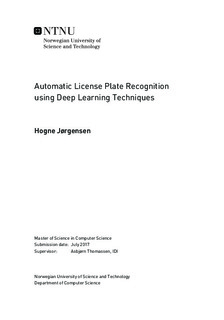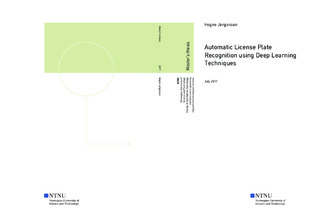| dc.description.abstract | Context: Automatic license plate recognition (ALPR) is used in many domains, such
as parking, border control and motorway road tolling. Its importance has increased
the recent years, with many new applications. High prediction accuracy and speed of
ALPR is vital. Recent improvements in deep learning have increased its ability to solve
complex visual recognition task. Using deep learning to improve the accuracy and speed
of solving the ALPR task is for this reason promising.
Goal: The goal of this thesis is to propose a method using deep learning techniques
solving the ALPR task and evaluate its processing speed and prediction accuracy.
Method: The research was divided into two stages. The first stage consisted of reviewing
publications on the ALPR task, and reviewing and evaluating deep learning
techniques, aiming at proposing a suitable method. The second stage consisted of evaluating
the proposed method. The main criteria in the evaluation was processing speed
and prediction accuracy. The dataset used to evaluate the prediction accuracy consisted
of parked cars with mostly Norwegian license plates.
Results: A method using two object detection convolutional neural networks (CNNs)
was proposed for the purpose of solving the ALPR task. The first network was retrained
to detect license plates, and the second network to segment and recognize characters
within the license plates detected by the first network. Both networks used the YOLOv2
architecture, as it was believed to be significantly faster and have slightly higher accuracy
compared to the other reviewed architectures. To our knowledge, the proposed method
is new and has never been evaluated on the ALPR task before.
The evaluation of the proposed method resulted in an overall prediction accuracy of
97.6%, significantly outperforming other methods tested on the same dataset. The license
plate detection achieved an accuracy of 99.8%, and the character detection an
accuracy of 97.8%. When running the proposed method on a GPU, it used on average
17ms to perform plate detection on an image and on average 16ms to perform character
detection on a plate, giving an overall processing time of 33ms per image. This is to our
knowledge faster than all other methods described in the literature, even substantially
faster than most of them. It is also fast enough to run on real-time video streams running
in up to 30 FPS without the need to drop any frames.
Conclusion: This thesis is the first evaluation of a method using deep object detection
CNNs to solve the ALPR task. The proposed method achieved very high prediction
accuracy and outperformed all other methods considering processing speed when using
a GPU. This suggests that using deep object detection CNNs is a good solution for the
ALPR task. | |

